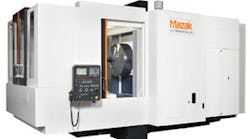Mazak chose its “T3 – Tomorrow’s Technology Today” event for the U.S. debut of a novel new machining capability, the Orbitec 20, which it explained offers an advanced approach to creating turned machining features on large, stationary odd shaped parts, that do not lend themselves easily to turning processes. For example, parts that require turning, threading, tapered boring, and phonographic facing can be finished easily and efficiently on the new design.
The T3 event is a two-week-long program that Mazak Corp. developed to demonstrate its machine tool technologies and developments. Held at Mazak’s U.S. center of operations in Florence, Ken., the machine builder estimated that the program drew attendance of about 1,500 over the two weeks, and it projected that the program of demonstrations, seminars, and instructional presentations represented “the largest, most comprehensive manufacturing technology solutions event ever held by a private company in the manufacturing industry.”
The turning effectiveness of the Orbitec 20 machine results from a patented headstock design that effectively generates features on parts by keeping the workpieces clamped and stationary, so that only the cutting tool is in motion. It is an internally counter balanced system with a 40 hp (30 kW), 600-rpm integrated spindle motor, so the tool tips face either toward or away from the centerline of rotation while tools orbit around workpieces. “This provides stable precision machining and less part interference because tools do not protrude beyond the rotating headstock when working on larger diameters,” Mazak detailed.
The headstock design is circular, as opposed to linear slides, within a circle for accurate linearly interpolated X-axis tool movement. To increase operators' access to the workpiece, the machine has an X-axis stroke measuring 11.02 in. (280 mm), while its U, V, and Z-axis strokes are 23.62 in. (600 mm), 23.62 in. (600 mm), and 48.43 in. (1,230 mm), respectively. The machine turns diameters up to 20 in. (508 mm), according to the tools selected for the work, on parts fitting into a working area measuring 41.34 in. (1,050 mm) in diameter and 51.18 in. (1,300 mm) high.
Part processing versatility is increased because the Orbitec 20 has a range of machining capabilities, including generating phonographic finishes on flange surfaces, cutting tapered bores, and grooving in feed-out operations. It is effective at trepanning, threading, internal grooving, drilling, and concave machining, too.
With a standard two-pallet changer and Mazak’s PMC-Web cell controller software available, the Orbitec 20 is easy to integrate into Mazak’s advanced Palletech automation system. Then, the machine can combine with Mazak Horizontal Center Nexus machining centers to create a complete, “lights out” manufacturing cell for large parts.
In a manufacturing cell of that type, workpieces fixtured once on the Orbitec 20’s 24.8×24.8 in. (630×630 mm) pallets feed into the machine for turning operations. Then, the Palletech system transports parts to the machining centers for secondary milling operations. Pallets and part fixtures make it possible to manufacture single-lot parts economically and effectively; tombstones with multi-part fixtures support higher production needs.
With Mazak’s PMC-WEB cell controller software over standard PCs and networks, shop managers can monitor operations, view and change schedules as needed, manage part program files from anywhere on the network, track tool life/breakage, and issue instructions to the shop floor. “Users are able to interrupt a planned machining queue and produce an emergency part with no cost penalty,” Mazak explained.







